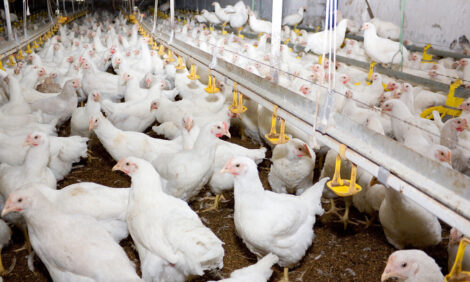



Avian Influenza Spreads Across Mexico
ANALYSIS - The highly pathogenic H7N3 Avian Influenza virus is spreading quickly across central Mexico, much to the frustration of the Mexican poultry industry. Chris Wright, writing for the ThePoultrySite, reports on the ANECA meeting held last week in Mexico.The Mexican poultry industry is in a state of panic over the Avian Influenza virus which is rapidly spreading across the country. Poultry producers are using phrases like: “disastrous,” “the end of industry,” “event of historic proportions” and “the devil is among us.”
Last week at the annual ANECA convention, the Mexican Association of Poultry Science Specialists, while many important issues were covered, the hot topic was the Avian Influenza problem.
One of the main issues is that officially, as reported by Mexican authorities and the OIE, Avian Influenza seems to be contained within one area of the country, while the industry believes it has spread far and wide.
During the conference a government official announced to the audience of hundreds of attendees, that the H7N3 virus had been isolated by PCR in the state of Puebla. This has not yet been officially published by Senasa in Mexico or the OIE. But the fact that it was stated by a government official in a public meeting assumes that the official publication will soon follow.
The reason this announcement is so important is that the main poultry production area of Puebla is the city of Tehuacan, which is the second most important egg production zone in Mexico. The distance from there to Tepatitlan, Jalisco – the original H7N3 outbreak zone in 2012 and top egg production area – is 770 km, an eight hour drive.
The fact that it has gone from point A to be point B with almost nothing in between, should raise a few eyebrows. To the Mexican poultry industry this confirms what they already believe: that everything between point A and point B is infected, which includes the major poultry production areas of the country.
To be fair to the government, other outbreaks besides the state of Jalisco have been identified as infected. The main new outbreak was reported in the state of Guanajuato this February, when its broiler and breeder farms were affected. But that area is contiguous to some of the poultry production areas in Jalisco state. And in late April the virus was discovered in the state of Tlaxcala, about halfway between points A and B, in backyard flocks.
Industry practices to blame
While the frustration with the government inaction is clear, the poultry industry is also quick to point to its own practices as the cause of disease spread. Four points stand out.
First is the lack of biosecurity. No matter how much emphasis has been placed on this since the H7N3 outbreak was reported in the state of Jalisco in June of 2012, it still appears that on many farms biosecurity practices are lacking. Case in point was the fact that broiler breeder farms, supposedly the most biosecure farms in the industry, were infected in February.
Second, the practice of sending untreated poultry litter to fruit and vegetable growers has not abated, and is considered by most as the cause of the disease spread. Farms that had been infected with H7N3 have sold the litter to the ag industry, instead of burying or composting it. They are supposed to compost or treat it before selling it, but apparently few farms do this.
Third is the selling of live spent hens. These live birds, both layers and breeders, are highly regarded in the live markets and the producers make a good profit on them. Some of these spent hens are also taken to other farms and molted for a second cycle.
Fourth is the nature of the Mexican poultry market itself, in which well over 30 per cent of the broilers are sold live.
All of this “poultry tourism” and “travelling poultry” has to stop, says the industry. They realize that they must now change their system drastically or suffer the consequences. Those consequences would be to become completely dependent on other countries, primarily the US, for their broilers and eggs.
Is vaccination working?
At this point in time, vaccination is the only control strategy. Last year a local vaccine was quickly developed and it stopped the outbreak in the state of Jalisco by the month of September. Although not until over 23 million commercial layers either died or were culled.
It was thought that between the vaccine and the quarantined areas that they had succeeded in stopping the disease. This was a false pause however, since the H7N3 virus reappeared in January, and in February moved into Guanajuato state and the broiler and breeder farms. And it has continued to move since then.
The vaccine is still being used and in March was authorized for use in many states that had not been affected, as a prophylactic measure. Previous to that it was only authorized for use in the directly affected areas.
But now the efficacy of the vaccine itself is being questioned. After what appeared to be a rather rote presentation by a government veterinarian about the vaccine, its production and quality control, the question and answer period was very provoking. The poultry veterinarians and producers were very interested in the subject, but also showed that they do not think the vaccine is working like it should. The long lived birds, layers and breeders, are getting three and sometimes four vaccinations, while the broilers are receiving one.
A new reality
If last year’s outbreak in one part of Jalisco state was considered catastrophic, with its loss of 23 million layers, what word can be used to describe this new outbreak which still affects layers but has moved into breeders and broilers and has apparently spread across the central part of the country? “Disastrous” does not seem to describe it properly.
For now, however, no new measures are planned besides continuing vaccination and trying to restrict movement from those identified areas.
For the Mexican poultry industry, which knows it has to change, there is a new reality, that the H7N3 virus is here to stay and they will have to learn to deal with it on a daily basis. This is the same thing that happened with the H5N2 low pathogenic Avian Influenza virus that has been around for close to 19 years, and is still there.
For the moment then, it looks like more bad news and very hard times lie ahead for the Mexican poultry sector.









